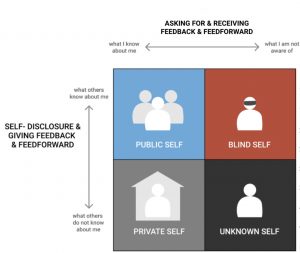What’s one thing you wouldn’t share with your team? Would it be in your best interest to share it? What’s something you weren’t previously aware of, but now you are?
These questions relate to different quadrants of the Interactive Feedback Matrix, a Vivo Team model for developing emotional intelligence (EQ) and a method for building collaboration. The Interactive Feedback Matrix is composed of four quadrants:

The Public Self – The public self indicates levels of self-awareness. It’s what others know and are aware of about you.
The Private Self – Opposite to the public self, the private self represents what others don’t know about you. A large private self can be suggestive of low level social skills.
The Blind Self – The blind self is what you are not aware of. In other words, it represents your own unawareness. Researchers have found that although 95% of people think they’re self-aware, only 10% to 15% actually are. (Harvard Business Review)
The Unknown Self – The unknown self represents your well of potential. For example, maybe there’s something you thought you couldn’t do, but now you do really well.
You might be wondering what this has to do with feedback. Self-disclosure and giving feedback, feedforward, and following up can increase your public self, resulting in deeper connection and collaboration with your teams and leaders. On the other hand, asking for feedback, feedforward and following up can help you with both your blind and unknown self. (Find out more about feedback, feedforward, and follow up here.)
The Interactive Feedback Matrix is more than just a personal tool, it can also be applied in a company setting.
Imagine you’re the leader of your team and you recently learned some change-related information, but you’re hesitant to share it with your team because you’re afraid it will create fragility and uncertainty.
In the context of the Interactive Feedback Matrix, this change-related information currently sits in the private quadrant, along with other items such as the organization’s financials, hiring/firing insight, etc.
The blind quadrant refers to what others know about you, but you aren’t aware of internally–perhaps customer service has gone awry but the company isn’t attune to this mishap.
Continuing with the organizational approach to the matrix, the unknown quadrant is simply just that–the unknown. Many organizations have likely sat in this quadrant at some point throughout the Covid-19 pandemic. The unknown, however, is where innovation and gems hide. Companies need to strategically harness these “unknowns” to add greater value to client experience.
And finally, the public quadrant. This refers to the public-facing brand of the company/organization–what employees and the public are aware of.
The matrix seamlessly shifts from being an individualized, personal tool, to being a company/organizational business tactic.
Understanding both the personal and organizational applications of the Interactive Feedback Matrix facilitates emotional intelligence, collaboration, and ultimately change resilience.
To start to uncover personal and company blind spots or to dig into that well of potential of the unknown, start asking for and giving interactive feedback.
.png?width=125&height=61&name=Logo%20-%20Vivo%20Team%20-%20White%20(2).png)

